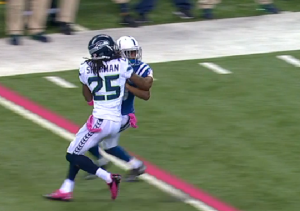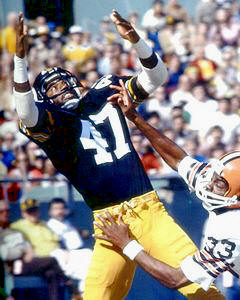Will Officials Really Increase Defensive Holding Calls During the Regular Season?
After watching Richard Sherman and other “top” defensive backs manhandle receivers during the 2013 season while rarely being penalized, the NFL has made a point of emphasis for 2014 to crack down on defenders using their hands to keep receivers from getting into their routes.
So far in the preseason officials have been throwing flags like confetti during a parade, but it is not yet clear whether NFL Week 1 odds should be adjusted to account for the change.
There is no question that in recent years some of the top defensive players in the league have been able to skirt the rules originally created in the late 1970s to keep defensive backs like Hall of Famer Mel Blount from completely dominating the game.
The 1978 rules to limit the ability of defenders to put hands on receivers were the first of a multitude of rules that have been created over the last 36 years that have helped increase offense within the game.
The impact in 1978 was immediate.
In 1977, only one quarterback, Joe Ferguson of the Buffalo Bills at 200.2 yards per game, averaged 200 yards passing per game and only Bob Griese (22) and Ken Stabler (20) had 20 or more touchdown passes.
The 1978 season did also see the addition of two more games, but regardless, the increase in passing offense was quite obvious. Fran Tarkenton led the league averaging 216 passing yards per game and six quarterbacks averaged 200 or more yards per game. In addition, Terry Bradshaw tossed 28 touchdown passes and four others eclipsed 20 touchdown passes.
Of course, that was just the start of the offensive explosion in the NFL. In 1979 Dan Fouts passed for 4,082 yards (255 per game) and 10 eclipsed 200 yards passing per contest.
In 1981 Fouts became the first quarterback in NFL history to average 300 yards per game and half of the teams in the NFL (14 of 28) had a starting quarterback who averaged more than 200 yards per game. Fouts and Steve Bartkowski of the Atlanta Falcons passed for at least 30 touchdowns and 11 quarterbacks had 20 or more touchdown passes.
Those numbers seem a bit pedestrian compared to the current game when 26 of 32 teams had a starting quarterback passing for more than 200 yards per game in 2013, but were important in the evolution of the game.
Surprisingly, even with such prolific offense, some defenses have still been able to have an impact. That was certainly the case in 2013 when the Seattle Seahawks allowed opponents only 14.4 points per contest.
They were especially dominant in the playoffs when they held both the New Orleans Saints and San Francisco 49ers nearly 10 points below their season averages to reach the Super Bowl.
Facing record setting quarterback Peyton Manning and the high-flying Denver Broncos in the Super Bowl, the Seahawks held the Broncos to only eight points, 30 points below their record average of 38 points per contest.
One of the key components of the dominant Seattle defense was a defensive backfield where 5-foot-10, 208 pound All-Pro Earle Thomas was the only player not 6-foot-3 or taller. Playing a physical style, the Seahawks limited opponents to only 190 passing yards per game and intercepted 28 passes while allowing only 16 touchdown passes.
Many complained that part of why the Seahawks were so dominant was because they were allowed to keep their hands on receivers significantly more than is allowed by the rules.
Thus, for 2014 defensive backs placing their hands on receivers beyond the five yard limits is supposed to be an area of increased emphasis for officials.
Certainly anyone who abuses rules should be penalized, but so far in preseason, which arguably is hard to watch anyway, the new emphasis has made it nearly unbearable to watch. Seemingly every series has at least one or two defensive penalties. In fact, it almost seemed like every time a pass is incomplete or a quarterback sacked you are just waiting for the officials to throw a flag and give the offense another chance.
With the exception of occasional great defenses like the 2013 Seahawks and previous units of the Baltimore Ravens, Pittsburgh Steelers and a handful of other teams, defense in the NFL today is at historically bad levels. So offenses don’t need any more help.
However, the muggings that Sherman and his teammates got away with last season should also not be tolerated.
It remains to be seen if the NFL can find a balance or if their determination to reduce the abuse of the five-yard rule will result in an even more disjointed and offensive leaning game in 2014.
There is no question the NFL is the most exciting and entertaining of all sports leagues, but if they are not able to find a level balance, things like the rash of defense penalties and pinball type offense onslaughts it could create could be one of those things that creates a chink in the armor.












